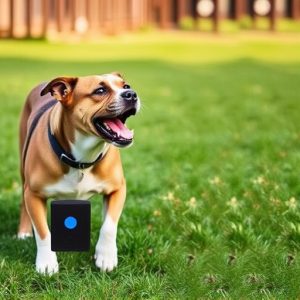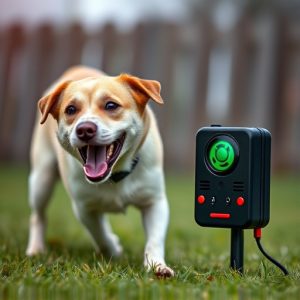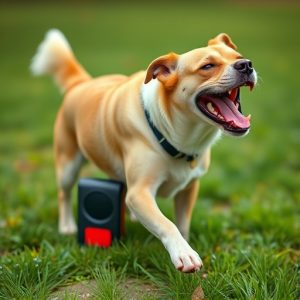Personal Protection: Understanding & Safeguarding Against Aggressive Dogs with Electronic Repellents
Understanding aggressive dog behavior is crucial for personal safety, especially when encountering u…….
Understanding aggressive dog behavior is crucial for personal safety, especially when encountering unfamiliar dogs. Aggression can stem from various causes like fear or previous negative experiences. Recognizing early signs and identifying root causes, such as using certified electronic dog repellents, is key for management. These devices emit high-frequency sounds to deter aggression without harm but should be used responsibly. Proper training, socialization, and regular exercise significantly reduce aggression. Opting for repellents that meet safety standards like UL ensures minimal risks to humans and pets. When facing aggressive dogs, prioritize personal safety by maintaining distance, avoiding eye contact, using repellents as a last resort, regularly training with them, and checking local regulations.
Personal protection from aggressive dogs is a vital concern for many individuals, especially given the rising prevalence of dog-related attacks. This comprehensive guide delves into understanding aggressive dog behavior, its signs, and underlying causes. We explore the role of electronic dog repellents, highlighting safety features and their effectiveness compared to traditional methods. Additionally, we emphasize ensuring product quality through certification standards for dog repellents. Best practices for personal protection are also provided, offering valuable tips for safe interaction with dogs.
- Understanding Aggressive Dog Behavior: Signs and Causes
- The Role of Electronic Dog Repellents: Safety Features and Effectiveness
- Ensuring Product Quality: Certification Standards for Dog Repellents
- Best Practices for Personal Protection: Tips for Safe Interaction with Dogs
Understanding Aggressive Dog Behavior: Signs and Causes
Understanding aggressive dog behavior is crucial for ensuring personal safety, especially when encountering unfamiliar dogs. Aggression in dogs can stem from various causes, such as fear, territorial instincts, pain or illness, and previous negative experiences. Recognizing the signs of aggression early on can help prevent potential incidents. Common indicators include raised fur, snarling, growling, stiffened posture, and rapid tail movements. These behaviors may escalate into lunging, barking aggressively, or even biting if not addressed promptly.
Identifying the root cause is essential for effective management. For instance, a dog with an electronic repellent certification can be a safe and humane way to deter aggressive behavior by emitting a high-frequency sound that disrupts their focus without causing harm. However, it’s important to note that these devices should adhere to safety standards and be used responsibly, as not all dogs respond in the same manner. Proper training, early socialization, and regular exercise can also significantly reduce aggression by addressing underlying fears and promoting positive behavior interactions.
The Role of Electronic Dog Repellents: Safety Features and Effectiveness
Electronic dog repellents have emerged as a modern solution for personal protection against aggressive dogs. These devices utilize sound, vibration, or spray to deter canine attacks, offering a non-lethal alternative to traditional methods. Repellents featuring safety standards and certifications ensure that they meet rigorous criteria for human safety and effectiveness.
The effectiveness of electronic dog repellents lies in their ability to trigger an instinctive response from the animal. When activated, these devices emit high-frequency sounds or vibrations that are unpleasant for dogs, causing them to pause, retreat, or become distracted. Repellents that comply with safety standards undergo extensive testing to guarantee minimal risk to users and bystanders. Regular maintenance and proper usage instructions, as provided by manufacturers, are crucial to ensure optimal performance and safety when using these electronic deterrents.
Ensuring Product Quality: Certification Standards for Dog Repellents
When considering personal protection from aggressive dogs, the quality and safety of dog repellents are paramount. Look for products that meet recognized certification standards to ensure their effectiveness and minimal risk. Independent testing and verification by reputable organizations like Underwriters Laboratories (UL) or similar international bodies guarantee that electronic dog repellents adhere to strict safety guidelines.
These certification standards assess the product’s overall construction, component quality, and performance in real-world scenarios. They also evaluate any potential hazards, ensuring the repellent is safe for both humans and pets. By choosing certified products, you gain peace of mind knowing that the device has undergone rigorous testing, reducing the risk of injury and enhancing your safety when facing aggressive canine encounters.
Best Practices for Personal Protection: Tips for Safe Interaction with Dogs
When interacting with aggressive dogs, prioritizing personal safety is paramount. One effective method to deter and protect against dog attacks is the use of electronic dog repellents. These devices operate under strict safety standards and certification regulations, ensuring their humane and reliable functionality. Repellents emit safe, low-level electric shocks that startle the dog, allowing you to maintain your distance and escape potential harm.
To ensure maximum effectiveness and safety, follow best practices: keep a safe distance, avoid direct eye contact, and use the repellent only as a last resort. Regular training and familiarization with the device are crucial. Additionally, always check local regulations regarding the use of electronic repellents to ensure compliance with community guidelines.
When it comes to personal protection from aggressive dogs, a multifaceted approach is key. By understanding canine behavior, choosing reputable electronic dog repellents that meet strict safety standards and certifications, and adhering to best practices during interactions, individuals can effectively deter and manage potential threats. Remember, prioritizing safety means staying informed, using technology responsibly, and always approaching dogs with caution.


